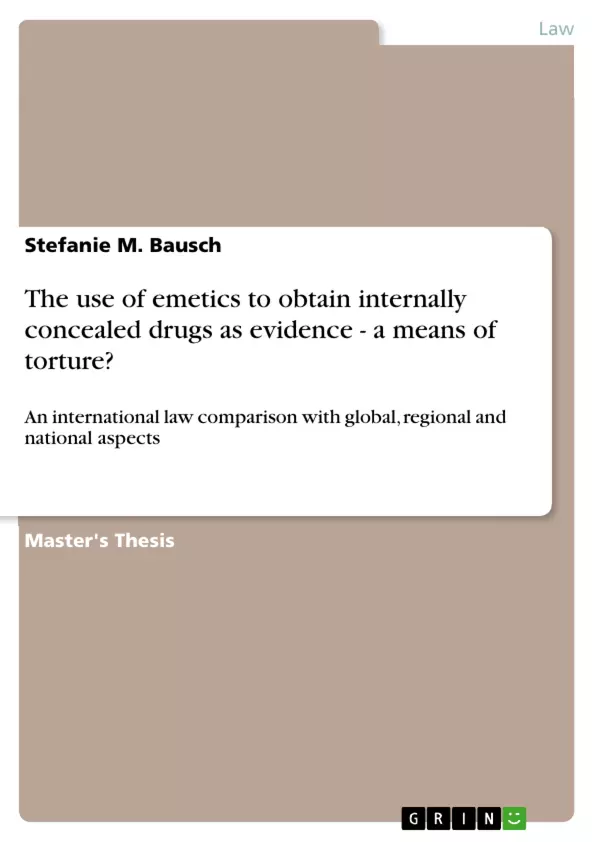In some German states vomit-inducing medication is undertaken as a means to search and seize evidence in drug street dealings. Whenever a drug dealer swallows drugs upon arrest, a medical practitioner administers a so-called emetic which makes the suspect vomit and which allows the Police to seize the evidence.
The thesis presents the legal basis and the constituent elements of this measure. It shows how the administration of the emetic takes place, where in Germany the method occurs and to what extent it is used. The thesis further compares the German measure to obtain evidence in cases of internal concealment with the Australian one. It shows that Australia, too, encounters problems of internal concealment and how Australian authorities react to such a challenge.
The thesis moves on in examining whether the administration of a vomit-inducing medicament in order to obtain evidence is compatible with International Law. It scrutinises if the use of emetics is a means of torture and thus infringes the suspect’s fundamental rights of human dignity and personal integrity. The thesis comes to the conclusion that the use of emetics does not amount to torture under Article 3 of the European Convention for the Protection of Rights and Fundamental Freedoms and Article 1 (1) of the United Nations Convention against Torture and Other Cruel, Inhuman or Degrading Treatment or Punishment.
Table of Contents
- First Part Introduction and aim and purpose of the thesis...
- I. Introduction
- II. Aim and purpose of the thesis_
- Second Part: Procedures of obtaining evidence in cases of internal concealment in Germany and Australia
- I. The German procedure....
- II. The Australian procedure
- III. Legal comparison and summary.
- Third Part: Admissibility of the use of emetics under international law
- International instruments aiming at the prohibition of torture.
- I. The use of emetics and the European Convention for the Protection of Rights and Fundamental Freedoms.
- 1. Travaux préparatoires_
- 2. Case law
- (1) Greek Case
- (2) Northern Ireland v. United Kingdom.
- (3) Aksoy v. Turkey..
- (4) Aydin v. Turkey.
- (5) Ahmet Çakıcı v. Turkey..
- (6) Selmouni v. France_
- (7) Salman v. Turkey.
- (8) Dikme v. Turkey...
- (9) Akkoç v. Turkey..
- (10) Elçi and Others v. Turkey.
- (11) Balogh v. Hungary...
- 3. Summary with regard to the case law..
- 4. The use of emetics as torture according to Art. 3 ECHR
- (1) Severe physical or mental suffering because of the use of emetics
- (a) Is the use of emetics generally admissible under Art. 3 ECHR? __________.
- (b) In what way does the emetic have to be administered in order to be lawful as per Art. 3 ECHR?
- (aa) Administration of ipecac syrup through a tube
- (bb) Injection of apomorphine
- (2) Intention of the use of emetic_
- (3) Purpose of the use of emetics under German law.
- (4) Public official administering the emetic
- 5. Summary of the use of emetics and Art. 3 ECHR.
- III. The use of emetics and the United Nations Convention against Torture and Other Cruel, Inhuman or Degrading Treatment or Punishment.
- 1. Scope of the prohibition of torture contained in the UNCAT
- 2. Application to the use of emetics_
- IV. Summary..
- Fourth Part: Conclusion and outlook
- The use of emetics as a method of evidence retrieval in cases of internal concealment.
- The legal framework for the use of emetics in Germany and Australia.
- The compatibility of the use of emetics with international human rights law, specifically the European Convention for the Protection of Human Rights and Fundamental Freedoms (ECHR) and the United Nations Convention against Torture and Other Cruel, Inhuman or Degrading Treatment or Punishment (UNCAT).
- The legal definition and application of the concept of torture in relation to the use of emetics.
- The ethical implications of using emetics as a method of evidence retrieval.
Objectives and Key Themes
This thesis aims to analyze the use of emetics to obtain internally concealed drugs as evidence and to explore its legal implications under international law, particularly in the context of the prohibition of torture. The study examines the legal frameworks and procedures in Germany and Australia, focusing on the admissibility of emetics in light of international human rights standards.
Chapter Summaries
The first part of the thesis introduces the topic of the use of emetics to obtain internally concealed drugs as evidence, outlining the aim and purpose of the study. It also sets the stage for exploring the legal and ethical dimensions of this practice.
The second part of the thesis examines the procedures for obtaining evidence in cases of internal concealment in Germany and Australia. It compares the legal frameworks and practices in both countries, highlighting the differences and similarities in their approaches.
The third part of the thesis delves into the admissibility of the use of emetics under international law. It analyzes the relevant provisions of the ECHR and UNCAT, focusing on the prohibition of torture and other cruel, inhuman or degrading treatment or punishment. The chapter examines the case law and legal interpretations related to the use of emetics, exploring whether such practices violate international human rights standards.
Keywords
The central keywords and themes of this thesis include: internal concealment, emetics, drug trafficking, evidence retrieval, torture, human rights, European Convention for the Protection of Human Rights and Fundamental Freedoms (ECHR), United Nations Convention against Torture and Other Cruel, Inhuman or Degrading Treatment or Punishment (UNCAT), legal comparison, Germany, Australia, international law, admissibility, case law.
- Quote paper
- Dr. Stefanie M. Bausch (Author), 2005, The use of emetics to obtain internally concealed drugs as evidence - a means of torture?, Munich, GRIN Verlag, https://www.grin.com/document/45463



